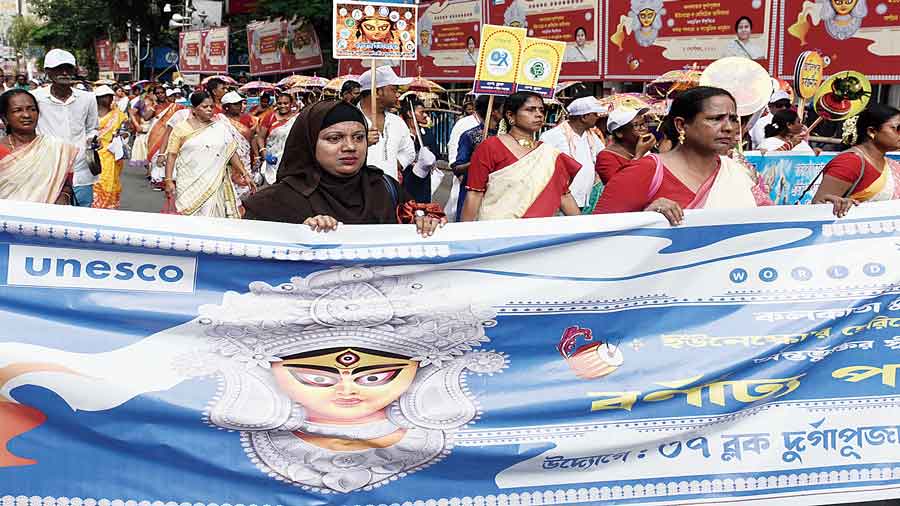A carnival of colours — with a vivid splash of the celebration of diversity and inclusiveness.
Participation transcending barriers of faith was one of the standout features of the procession to celebrate Unesco’s inclusion of Calcutta’s Durga Puja on the list of “intangible cultural heritage”. Thursday’s roadshow was a testament to the spirit of inclusiveness that makes Durga Puja more a social festival than a religious ritual.
Tabassum Parveen and Farhat Ali were part of a team from Mirzapur Palli Durga Puja in Sealdah. Along with a handful of other women, the two walked holding the banner of their puja. Tabassum was wearing a hijab while Farhat wore a sari.
Nothing unusual for them. “I have been taking part in the puja for years. The evening aarati is my favourite,” said Tabassum, a homemaker.
Abdul Wajid came with a team from Fatehpur Durgotsab in Garden Reach. “I have been involved in Saraswati and Durga Puja since my college days,” said Wajid, a private tutor in his fifties.
After the inclusion of Durga Puja on its roll of honours, Unesco had said: “During the event, the divides of class, religion and ethnicities collapse as crowds of spectators walk around to admire the installations.”
Mirroring that statement on Thursday was Central Avenue.
Rohit Singh, a young man in a turban, represented Ramakrishna Athletic Club in Howrah. The BCom honours student has been involved in the pandal and decoration of the puja for the past few years.

Hardev Singh (left) from New Alipore Suruchi Sangha
“I have known only this way of living together in harmony. This is the lesson I got from my parents,” said Rohit.
Sk Motiur came as a representative of the puja organised by Shantidoot Sporting Club in Patuli. The labour contractor in his forties is among the key organisers of the 30-year-old puja.
“From bringing the idol to buying ingredients for the bhog, Motiur is indispensable,” said Gauranga Basak, another member of the puja committee.
Motiur was too shy to talk. After much persuasion, he said: “I have always considered the puja as my own. I don’t think there is anything special about this.”
When Motiur’s group, at the tail of the rally, was on Vivekananda Road, Tabassum’s was in the middle, near Medical College on Central Avenue. The head of the rally was near Chandni Chowk Metro station at the same time, another 1.5km from Medical College.
Police said over 40,000 people attended the rally.
Around 1pm, the mercury was sizzling at 34 degrees Celsius. But the real-feel temperature was 44 degrees. The city seemed like a cauldron. Minutes later, rain started. The showers lasted for around 35 minutes.
The rally started just before 2pm. By the time chief minister Mamata Banerjee reached Red Road, it was past 3pm. The tail of the rally was still at Girish Park, around 4km north.
“I may be Hindu, Muslim, Sikh, Jain or Christian. I may be from any caste. But unity is our only caste and religion,” Mamata said from the Red Road dais on Thursday.
Khushboo Parveen, part of a group of women from Kidderpore 25 Palli who blew conch shells, embodied that spirit. Every year, Parveen lends a hand in cooking the bhog for the goddess. “I wait for Durga Puja through the year,” she said.
If the size of the rally was impressive, the carnival mood was also something the city had not seen in recent years.
Many groups danced to the beats of dhak and dhamsa and madol. Chhau masks and men on stilts were the attraction for many shutterbugs. The participants from the puja committees came colour-coordinated. “Thank You Unesco” posters and banners were too many to count.
As the rally began, the windows, balconies and terraces of the homes along the route became crowded. Everyone wanted to grab a view.
Hardev Singh, a Sikh, was part of the colourful contingent from New Alipore Suruchi Sangha. “I have grown up in this city. This is my home. The culture of inclusiveness is ingrained here,” Singh, 68, who owns a motor spare-parts shop on Princep Street.
Some 200 metres ahead of Singh walked Firhad Hakim, the mayor of Calcutta. Hakim has been the driving force behind Chetla Agrani, one of the big-ticket pujas in the city.
On the same compound where the Agrani puja is held, stands a mosque.
“Calcutta is an example of inclusiveness. This was one of the major factors that helped in securing the Unesco tag. When the country is full of religious fanatics, Calcutta shows that communal amity can be part of the everyday lives of people,” Hakim told The Telegraph as he walked.
Hundreds of bystanders stood behind barricades at Central Avenue’s intersection with MG Road, many of them taking pictures of the rally. Ved Prakash Joshi, a resident of Vivekananda Road, came with his grandchildren to see the rally.
“Durga Puja is the biggest festival. Today’s rally befits the global recognition bestowed on the festival,” said Joshi.
The application for Durga Puja’s inclusion was made by the Union culture ministry in 2019 when Sangeet Natak Akademi had asked art historian Tapati Guha Thakurta to compile a dossier.
The application stated that Durga Puja was originally “a Hindu religious event, but now the celebrations transcend all barriers of religion and creed, making it a grand celebration, an exultation of spirit”.












